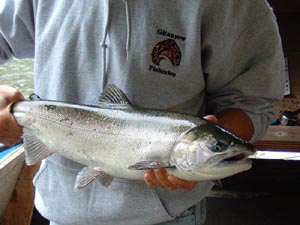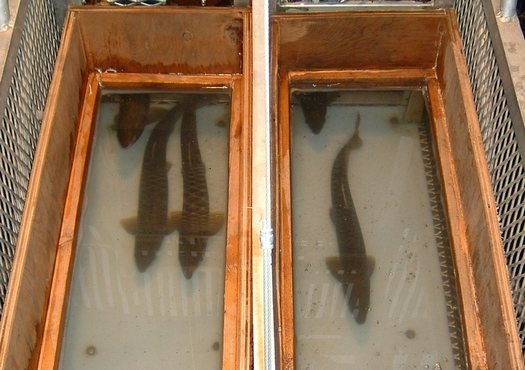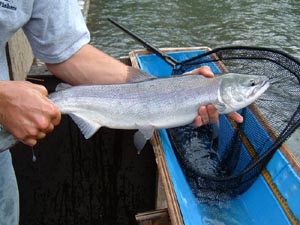Kitwanga River Salmon Enumeration Facility
.jpg) The Kitwanga River Salmon Enumeration Facility (KRSEF) has been operating annually since 2003. It is a permanent fence structure with removable panelsdesigned to trap and allow identification and enumeration of upstream migrating salmon. The KRSEF is located approximately 4 km upstream of the Kitwanga - Skeena River confluence, near the village of Kitwanga, B.C. It is arguably the most valuable component of the overall Kitwanga River Sockeye Recovery Plan - a strategy developed in 2006 to rebuild the once abundant Kitwanga sockeye from the point of near extinction. The Kitwanga sockeye have been a vital resource for the Gitanyow people, who have relied on the run for food for thousands of years, and who have voluntarily stopped fishing the stock since the early 1970's.
The Kitwanga River Salmon Enumeration Facility (KRSEF) has been operating annually since 2003. It is a permanent fence structure with removable panelsdesigned to trap and allow identification and enumeration of upstream migrating salmon. The KRSEF is located approximately 4 km upstream of the Kitwanga - Skeena River confluence, near the village of Kitwanga, B.C. It is arguably the most valuable component of the overall Kitwanga River Sockeye Recovery Plan - a strategy developed in 2006 to rebuild the once abundant Kitwanga sockeye from the point of near extinction. The Kitwanga sockeye have been a vital resource for the Gitanyow people, who have relied on the run for food for thousands of years, and who have voluntarily stopped fishing the stock since the early 1970's.
Although the fence was primarily constructed to enumerate sockeye, it is strategically located and operated to enable the enumeration of all species of Kitwanga River salmon - a feat which has been accomplished in most years since it was built.  In addition to providing a measure of absolute abundance of Chinook, sockeye, pink, chum and coho salmon, the fence also allows the capture of fish and the observation of condition. In 2010, GFA crews captured a percentage of sockeye, Chinook, chum and coho salmon and collected information on fish length, age (through collecting scales), DNA and sex. For sockeye and coho, crews observed each fish for missing adipose fins. In 2007 and 2008, GFA released hatchery raised sockeye into the upper Kitwanga watershed, clipping the adipose fins to mark them. These fish were then enumerated as they migrated to the ocean as smolts, through another GFA facility - the Kitwanga Smolt Enumeration Facility. At this facility, each smolt was observed, enumerated and observed for a missing adipose fin. Through the use of these two facilities, GFA can determine with accuracy the overall success of the hatchery program, by calculating the rate of smolt survival from fry stage, and the rate of return of sockeye spawners based on the number of smolts that migrated to sea.
In addition to providing a measure of absolute abundance of Chinook, sockeye, pink, chum and coho salmon, the fence also allows the capture of fish and the observation of condition. In 2010, GFA crews captured a percentage of sockeye, Chinook, chum and coho salmon and collected information on fish length, age (through collecting scales), DNA and sex. For sockeye and coho, crews observed each fish for missing adipose fins. In 2007 and 2008, GFA released hatchery raised sockeye into the upper Kitwanga watershed, clipping the adipose fins to mark them. These fish were then enumerated as they migrated to the ocean as smolts, through another GFA facility - the Kitwanga Smolt Enumeration Facility. At this facility, each smolt was observed, enumerated and observed for a missing adipose fin. Through the use of these two facilities, GFA can determine with accuracy the overall success of the hatchery program, by calculating the rate of smolt survival from fry stage, and the rate of return of sockeye spawners based on the number of smolts that migrated to sea.
The reason that coho salmon in 2010 were missing adipose fins is that in 2009, GFA crews started a coded-wire tagging program for coho smolts captured at the smolt enumeration facility, and marked them with an adipose clip. This allows GFA biologists to determine the ocean survival rates of wild coho smolts that migrated from the system, and will provide DFO and GFA fisheries managers with information on coho harvest rates and harvest locations at sea.
.jpg)
Each year in early July, before salmon start entering the Kitwanga River, GFA crews install the panels and counting boxes to a concrete sill that exists permanently in the river. The panels block upstream access for spawning fish and the counting boxes are then staffed during typical salmon migration times (morning and evening) to allow crews to identify and count every fish as they pass upriver. When the counting boxes are opened by staff, fish are able to migrate upstream through one of two boxes, located on each side of the river. On each side they can swim through one of two chutes where they pass over a white teflon surface that provides contrast and aids in observing identifying features of the fish. With a plexiglass box floating on the water surface, the glare is reduced. The chutes can be adjusted to an optimum depth that permits easy movement for fish and is still shallow enough to get a good look at the fish.  Fish are enumerated each year, typically until mid to late October until the runs have moved upstream past the fence and the water levels get too high to keep the fence in.
Fish are enumerated each year, typically until mid to late October until the runs have moved upstream past the fence and the water levels get too high to keep the fence in.
The KRSEF has arguably been one of B.C.'s most successful salmon spawner enumeration projects over the last decade. It provides valuable information to Gitanyow and DFO fisheries biologists and managers. In combination with the Kitwanga Smolt Enumeration Facility, GFA has been able to calculate the smolt production per female sockeye spawner - a key metric that has proven that Gitanyow Lake (aka Kitwanga or Kitwancool Lake), is one of the most productive sockeye nursery lakes for it's size in B.C. By getting an absolute count of sockeye, and all salmon species in the Kitwanga River, on an annual basis, it provides another indicator of the impacts of coastal and in-river commercial economic fisheries.
For the Gitanyow people it is a key tool in enabling them to restore stability to the Kitwanga sockeye - a genetically unique sockeye stock .
.
For more photos of the KRSEF, or other GFA projects, go to our photo gallery. For updates from the KRSEF and copies of reports, click here.

